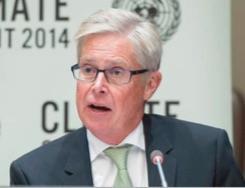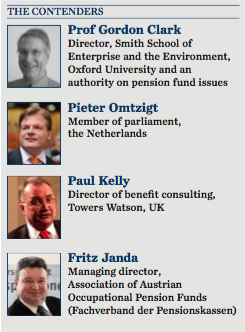Leading the fight to control climate change

Few European pension fund chief executives will get to address the United Nations general assembly. Yet Mats Andersson, CEO of Sweden’s fourth pension buffer fund Fjärde AP-fonden (AP4), achieved this accolade in September this year. The hon- our of addressing the UN underlines Anders- son’s commitment and proactive attitude not only towards climate change risk but also in his work on other projects that are aligned with the AP4’s long-term interests. By far the main project he has dedicated himself to recently is the reduction of the scheme’s carbon footprint. His work in this area ultimately led to his UN address this autumn.
This year, leading commentators including Martin Wolf of the Financial Times and Hank Paulson, former US Treasury secretary, have warned about the risks faced by companies exposed to climate change and stranded assets. Together with Amundi, MSCI and France’s FRR, Andersson has spearheaded a transparent index-based strategy that decreases portfolio greenhouse gas emissions with virtually zero tracking error risk. Andersson has already committed €1bn of AP4’s assets to these strategies and his ultimate goal is for AP4 eventually to decarbonise its entire portfolio.
But Andersson’s carbon-related risk management credentials do not stop there. Underlining this industry-leading decarbonising strategy, Andersson has also taken a pre-eminent role in the Portfolio Decarbonisation Coalition (PDC) that was launched in September when Andersson addressed the UN, with AP4 the lead pension fund. Together with the UN Environment Programme Finance Initiative, the PDC is a multilateral initiative that will drive reductions in greenhouse gas emissions by encouraging institutional investors gradually to decarbonise their portfolios. Members of the coalition share a dual vision and are setting themselves two corresponding but interconnected targets.

First, it should become common practice for investors to measure and disclose their carbon exposure footprint, otherwise expressed as the carbon intensity of their capital. Second, based on carbon-footprint information, a critical and growing mass of investors worldwide needs to start taking action to reduce the carbon intensity of their investments and portfolios.
The PDC’s disclosure target for portfolio decarbonisation strategies is a minimum of $500bn (€400bn) of institutional assets. An interim target of $100bn has been set, to be achieved by reducing the carbon risk inherent in equities by the end of 2015.
Portfolio decarbonisation can be achieved by withdrawing capital from particularly carbon-intensive companies, projects and technologies in each sector and by re-investing that capital into particularly carbon-efficient companies, projects and technologies of the same sector. A critical mass of institutional investors signing up to decarbonise their portfolios should send a strong and unequivocal signal to carbon-intensive companies that carbon efficiency is now centre-stage.
When large institutional investors start to reallocate capital on the basis of companies’ greenhouse gas emissions it provides a strong incentive for those companies to re-channel their own investments from carbon-intensive to low-carbon activities, assets and technologies.
The PDC will set-up an operations unit that will initially be housed at the United Nations. It will pursue a number of complementary tasks to help the coalition achieve its two intermediary targets, including:
- Communication and outreach campaigns to secure investor commitments on carbon footprinting and/or portfolio decarbonisation
- Research and analysis to resolve procedural and technical issues
- Orientation services to members and interested institutions on how to fulfil commitments
- Engagement with governments on the eventual financial regulatory components of these concepts.
Andersson’s achievement is undoubtedly a considerable contribution not just to the European pension and global institutional investment communities. AP4’s carbon index strategy is already under way, using a dynamic investment strategy to decarbonise its US equities and emerging markets portfolios in a way that lowers carbon intensity by 50–80% without sacrificing investments returns or tracking error risk against the benchmark. Based on this promising beginning, AP4 is now committed to decarbonise its entire equity portfolio. Mats Andersson







No comments yet